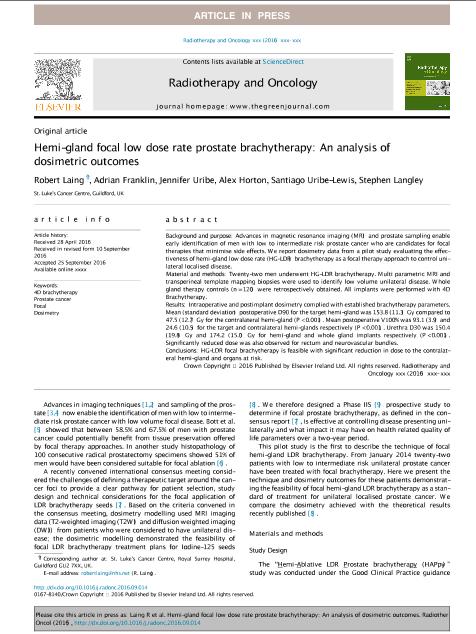Hemi-gland focal low dose rate prostate brachytherapy: An analysis of dosimetric outcomes
摘要:Abstract Background and purpose Advances in magnetic resonance imaging (MRI) and prostate sampling enable early identification of men with low to intermediate risk prostate cancer who are candidates for focal therapies that minimise side effects. We report dosimetry data from a pilot study evaluating the effectiveness of hemi-gland low dose rate (HG-LDR) brachytherapy as a focal therapy approach to control unilateral localised disease. Material and methods Twenty-two men underwent HG-LDR brachytherapy. Multi parametric MRI and transperineal template mapping biopsies were used to identify low volume unilateral disease. Whole gland therapy controls (n = 120) were retrospectively obtained. All implants were performed with 4D Brachytherapy. Results Intraoperative and postimplant dosimetry complied with established brachytherapy parameters. Mean (standard deviation) postoperative D90 for the target hemi-gland was 153.8 (11.3) Gy compared to 47.5 (12.7) Gy for the contralateral hemi-gland (P < 0.001). Mean postoperative V100% was 93.1 (3.9) and 24.6 (10.5) for the target and contralateral hemi-glands respectively (P < 0.001). Urethra D30 was 150.4 (19.8) Gy and 174.2 (15.0) Gy for hemi-gland and whole gland implants respectively (P < 0.001). Significantly reduced dose was also observed for rectum and neurovascular bundles. Conclusions HG-LDR focal brachytherapy is feasible with significant reduction in dose to the contralateral hemi-gland and organs at risk.
关键词:
论文方向:[{"id":912,"name":"肿瘤学"}]
发表期刊:Radiotherapy and Oncology Volume 121, Issue 2
发表时间:Wed Nov 30 00:00:00 CST 2016
数字识别码:10.1016/j.radonc.2016.09.014
是否作者本人: 否
版权及免责声明:
本网站所有论文文件均系用户自行上传或提供,本网站对其内容准确性及合法性概不负责,亦不承担任何法律责任。论文版权归原作者及原出处所有。
如您发现网站其他用户上传的论文有侵犯您的姓名权、隐私权、著作权或其他合法权益现象的,请及时与本网站联系并附加相关权利证明文件,以便本网站及时作出处理,维护您的合法权益。
本网站拥有对此声明的最终解释权。






{replyUser1} 回复 {replyUser2}:{content}